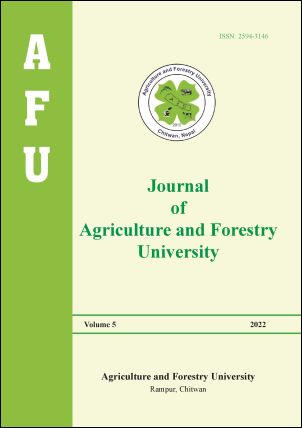Isolation and antibiotic sensitivity of Salmonella typhimurium isolates from poultry farms and slaughterhouses of Chitwan, Nepal
DOI:
https://doi.org/10.3126/jafu.v5i1.48476Keywords:
Antibiotic, isolation, poultry, resistance, S. typhimuriumAbstract
Nepalese poultry sector is progressing rapidly contributing around 4% of GDP with flourishing impact to provide sustainable and cheapest protein as source of human food. However, with the accelerating pathway, this industry is shed-back by outbreak of several infectious and zoonotic diseases impacting huge economic losses. Salmonella also cause infection in poultry birds and constitutes the largest reservoir of Salmonella organisms in nature. S. typhimurium is an unadopted serotype of Salmonella that may be transmitted to human, animals (poultry) and environment from contaminated food, feed and water. Use of antibiotics, good farm management practices and biosecurity are the treatment and control measures of this disease in poultry production. Development of antibiotic resistant strains of S. typhimurium thus not only pose considerable threat to clinicians, but is also of public health concern as these resistant strains after ingestion are capable of transferring resistance to other pathogens. The present study was undertaken to determine prevalence and antibiotics sensitivity of S. typhimurium strains isolated from domestic poultry from Chitwan, Nepal. Out of 79 farm and 23 chicken slaughterhouse sampling sites, the 107 (19.45%) out of 550 cultured specimens were confirmed for S. typhimurium. Amongst various antibiotics used for in vitro sensitivity testing, the two antibiotics: Colistin (Cl) and Enrofloxacin (Ex), were found to be 100% effective, whereas out of 22 antibiotics, 18 antibiotics showed weak to strong resistance pattern against S. typhimurium isolate. In the present study, Polymyxin and fluoroquinolone antibiotics were found to be most effective against S. typhimurium. Understanding the source of exposure to pathogens (especially resistant pathogens) provides some insight into antibiotic use and misuse in the region. Looking through the lens of One Health approach, the regulation of antibiotic use in animal medicine has direct implications for human health through the increased resistance of foodborne pathogens to vital antibiotic therapy. Thus, judicious use of antibiotics based on their sensitivity pattern should be practiced.
Downloads
Downloads
Published
How to Cite
Issue
Section
License
Copyright (c) 2022 Agriculture and Forestry University (AFU), Rampur, Chitwan, Nepal

This work is licensed under a Creative Commons Attribution-NonCommercial 4.0 International License.
This license allows reusers to distribute, remix, adapt, and build upon the material in any medium or format for noncommercial purposes only, and only so long as attribution is given to the creator.




